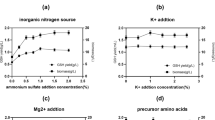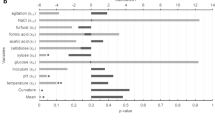Abstract
A strategy of experimental design using a fractional factorial design (FFD) and a central composite rotatable design (CCRD) were carried out with the aim to obtain the best conditions of temperature (20–30°C), agitation rate (100–300 rpm), initial pH (5.0–7.0), inoculum concentration (5–15%), and glucose concentration (30–70 g/l) for glutathione (GSH) production in shake-flask culture by Saccharomyces cerevisiae ATCC 7754. By a FFD (25–2), the agitation rate, temperature, and pH were found to be significant factors for GSH production. In CCRD (22) was obtained a second-order model equation, and the percent of variation explained by the model was 95%. The results showed that the optimal culture conditions were agitation rate, 300 rpm; temperature, 20°C; initial pH, 5; glucose, 54 g/l; and inoculum concentration, 5%. The highest GSH concentration (154.5 mg/l) was obtained after 72 h of fermentation.

Similar content being viewed by others
References
Alfafara C, Miura K, Shimizu H, Shioya S, Suga K (1992) Cysteine addition strategy for maximum glutathione production in fed-batch of Saccharomyces cerevisiae. Appl Microbiol Biotechnol 37:141–146
Cha J, Park J, Jeon B, Lee Y, Cho Y (2004) Optimal fermentation conditions for enhanced glutathione production by Saccharomyces cerevisiae FF-8. J Microbiol 42:51–55
Katapodis P, Christakopoulou V, Kekos D, Christakopoulos P (2007) Optimization of xylanase production by Chaetomium thermophilum in wheat straw using response surface methodology. Biochem Eng J 35:136–141
Li Y, Chen J, Mao Y, Lun S, Koo Y (1998) Effect of additives and fed-batch culture strategies on the production of glutathione by recombinant Escherichia coli. Process Biochem 33:709–714
Li Y, Wei G, Chen J (2004) Glutathione: a review on biotechnological production. Appl Microbiol Biotechnol 66:233–242
Li Y, Hugenholtz J, Sybesma W, Abee T, Molenaar D (2005) Using Lactococcus lactis for glutathione overproduction. Appl Microbiol Biotechnol 67:83–90
Liu C, Hwang C, Liao C (1999) Medium optimization for glutathione production by Saccharomyces cerevisiae. Process Biochem 34:17–23
Meister A, Anderson ME (1983) Glutathione. Annu Rev Biochem 53:711–760
Owens CWI, Belcher RV (1965) A colorimetric micro-method for the determination of glutathione. Biochem J 94:705–711
Rollini M, Manzoni M (2006) Influence of different fermentation parameters on glutathione volumetric productivity by Saccharomyces cerevisiae. Process Biochem 41:1501–1505
Sakato K, Tanaka H (1992) Advanced control of glutathione fermentation process. Biotechnol Bioeng 40:904–912
Wei G, Li Y, Du G, Chen J (2003a) Effect of surfactants on extracellular accumulation of glutathione by Saccharomyces cerevisiae. Process Biochem 38:1133–1138
Wei G, Li Y, Du G, Chen J (2003b) Application of two-stage temperature control strategy for enhanced glutathione production in the batch fermentation by Candida utilis. Biotechnol Lett 25:887–890
Wen S, Zhang T, Tan T (2004) Utilization of amino acids to enhance glutathione production in Saccharomyces cerevisiae. Enzyme Microb Technol 35:501–507
Wen S, Zhang T, Tan T (2005) Optimization of the amino acid composition in glutathione fermentation. Process Biochem 40:3474–3479
Wu G, Fang Y, Yang S, Lupton JR, Turner ND (2004) Glutathione metabolism and its implications for health. J Nutr 134:489–492
Zhang T, Wen S, Tan T (2007) Optimization of the medium for glutathione production in Saccharomyces cerevisiae. Process Biochem 42:454–458
Acknowledgements
The authors would like to thank the financial support from The National Council for Scientific and Technological Development (CNPq) of Brazil.
Author information
Authors and Affiliations
Corresponding author
Rights and permissions
About this article
Cite this article
Santos, L.O., Gonzales, T.A., Úbeda, B.T. et al. Influence of culture conditions on glutathione production by Saccharomyces cerevisiae . Appl Microbiol Biotechnol 77, 763–769 (2007). https://doi.org/10.1007/s00253-007-1211-6
Received:
Revised:
Accepted:
Published:
Issue Date:
DOI: https://doi.org/10.1007/s00253-007-1211-6




